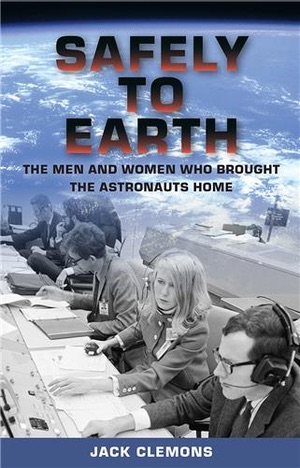Review: Safely to Earthby Jeff Foust
|
| “At 6 g’s I’ll be pretty much flattened into my seat,” the astronaut told him. “I suggest you come up with a different plan.” |
Unlike many people from that generation, Clemons writes that he didn’t grow up wanting to be an engineer. He didn’t have an interest in model rocketry, and an Erector set he got for Christmas at the age of six was put aside after a couple weeks. An interest in astronomy stimulated by his brother-in-law, as well as Kennedy’s lunar mission mandate, led him to pursue aerospace engineering in college, followed by a job at General Electric working on nose cones for ICBMs. Eager to get involved with Apollo, he later got a job with TRW, a contractor doing “engineering grunt work” on the program for NASA.
Given his experience working on ICBM nose cones, Clemons was put to work supporting reentry of the Apollo command module, developing backup reentry procedures for the astronauts to follow if the spacecraft’s computer malfunctioned. That work, which makes up a large part of the book, involved extensive interactions with fellow engineers, managers, and even astronauts. In one such anecdote, Clemons recalls meeting with an astronaut—probably Ken Mattingly, he recalls, but adds it might be Mike Collins—about reentry plans, which involved keying in values during the peak of reentry, around 6.5g. “At 6 g’s I’ll be pretty much flattened into my seat,” the astronaut told him. “I suggest you come up with a different plan.”
Clemons handled reentry planning for many of the Apollo missions to the Moon as well as the later Skylab launches. He then changed jobs, moving to IBM (after, he recalls, TRW botched a contract to perform support work for the shuttle) to help develop the software for the orbiter. That work, which he continued until the mid-1980s, offered its own set of challenges, in particular cramming the complex software needed to operate the orbiter into its limited onboard hardware. (At the time, he notes, “computer hardware was a scarce and expensive resource, and labor was cheap by comparison,” the opposite of today’s circumstances.) He left the space program for good in the mid-80s.
Safely to Earth doesn’t offer any great new insights into the Apollo or shuttle programs, other than a few tidbits here and there (Clemons notes that, while at TRW, he was involved at some early shuttle studies that considered Cape Hatteras, North Carolina, as a potential launch site since it could handle both polar and equatorial launches; it’s not clear that this concept was seriously evaluated by NASA, though.) It does, though, serve as a reminder that Apollo was possible thanks not just to the astronauts, politicians, and key engineers, but also by a workforce of thousands, whose even rank-and-file members have interesting stories to tell about the race to the Moon.
Note: we are temporarily moderating all comments subcommitted to deal with a surge in spam.
